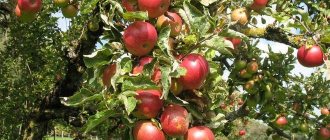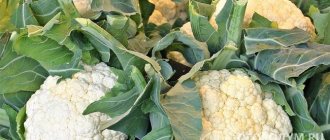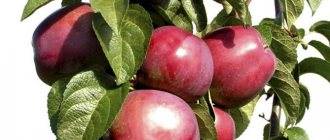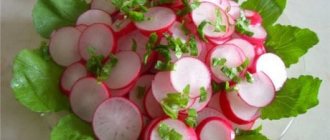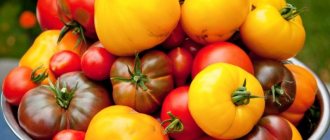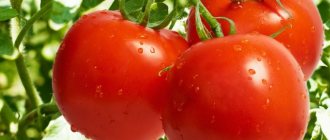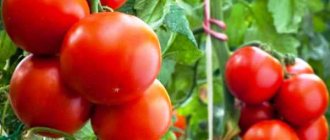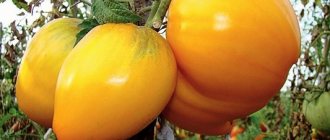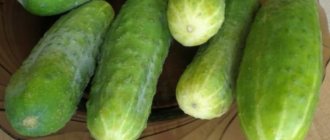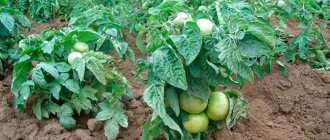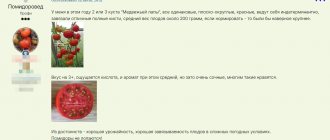Author's rating
Author of the article
Yakov Pavlovich
Professor, Head of the Department of Vegetable Growing
Articles written
153
The characteristics of a cold climate determine the choice of vegetables for planting. The advice of experienced gardeners will help you choose the best varieties of tomatoes for the northwest. Hybrids must tolerate weather changes, withstand heavy rainfall and temperature changes. Adapted varieties ripen quickly and produce a rich harvest.
Characteristics of climatic conditions from the point of view of growing tomatoes
The best varieties and hybrids of tomatoes for the North-West, according to reviews from professional vegetable growers, experienced amateurs and even amateurs, were grown by local breeders, although you should not limit yourself to them only. An excellent selection of tomato varieties is offered by “SeDeK”, “Aelita”, “Gavrish”, “SibSad” and “Sortsemovoshch”. Because the unfavorable weather conditions for growing in Siberia and the Urals, in the Far Eastern District largely coincide with the harsh climatic features of the Leningrad region and areas closer to the north:
- For greenhouse crops, which prevail in industrial farming, there is no need to make any special distinctions between Siberia and the chilly North-West, with its continental climate.
- Experienced gardeners use proven crops when choosing the right one, but in order to form a list of preferences, it is necessary to periodically experiment. You need to not just look at the ratings (the best varieties of 2022, 2022 and even 2019), the most productive or the most resistant to cold.
- There are recommendations from the originators, reviews from people who have been growing a certain species for a long time, and distinctions based on a number of requirements.
- For the North-West, two categories are usually recommended - ultra-early, cold-resistant, low-growing - for planting in open ground. They manage to ripen during a short cloudy summer with relatively low temperatures.
- Preference is given to small-sized fruits, because large-fruited ones do not have time to ripen here in the open ground. And even if it turns out with a harvest, it is rarely possible to achieve the dimensions declared by the manufacturer.
- For greenhouses, cultivars that are productive and easy to care for are predominantly chosen. Here you need to focus on the method of greenhouse cultivation: greenhouses, fundamental structures with heating and lighting at an industrial level, polycarbonate greenhouses or simple film shelters.
It is very simple to purchase tomato seeds, focusing only on a colorful picture, but you need to take into account that climatic conditions may not allow you to get the promised presentable harvest. The main selection criterion is suitability for the region, and only then they are selected according to other criteria - suitability for growing in a greenhouse or open ground, yield, type of bush, ripening time. It is worth paying attention to the varieties included in Rosreestr, proposals from “Siberian Garden”, “Sibiriyada”, “Seeds of Altai”.
Leningrad giant
Large-fruited tomato with excellent taste and juicy pink flesh. Leningrad giant is an early ripening variety. Its harvest ripens in 90 days. The bush is low, in a greenhouse it does not exceed 90 cm.
Characteristic
The Leningrad giant has a low, weakly leafy bush with carved, dark green plates. The fruits of the variety are large (more than 300 g), flat-round, pink in color without green shoulders. The skin of ripened tomatoes is dense. The pulp is fleshy and juicy. The taste is characterized as dessert, rich.
Features of planting and care
The cold-resistant giant can be sown directly into a greenhouse by the end of March. The tomatoes are not tall, but require garter due to the heavy fruits. Stepping is mandatory for the variety.
Leningrad giant bushes require abundant watering and additional potassium nutrition. Watering with potassium monophosphate is carried out at least twice a season: before flowering and when setting tomatoes. Fertilizing increases the sugar content of fruits, prevents cracking and increases shelf life.
The best varieties and hybrids of tomatoes for the North-West for greenhouses
The desire to grow tomatoes in open ground is usually based on the belief that the taste characteristics of greenhouse vegetables are inferior to so-called natural ones. But this is an erroneous opinion, because if you choose the wrong variety for the climate, then there will be no pleasure from the small sour fruits that have managed to acquire color during the short northern summer.
In much the same way, we need to abandon the established stereotype that hybrids are inferior to original crops in taste. In any case, everything depends on proper care, correct agricultural technology, compliance with growing conditions and proper feeding.
Preference is given to tall bushes, from which trellises can easily be formed, protecting the spoilage of fruits from contact with the ground and facilitating the hard work of the vegetable grower. Here, too, species with a short ripening period are chosen in order to reduce the cost of creating light and suitable temperature.
The longer tomatoes ripen, the more expensive they cost their owner. Experience has shown that it is possible to grow both gigantic tomatoes and cherry tomatoes under industrial conditions. But in a small private farm, it is better to turn to plants that are less demanding and more expedient to grow, focusing on early crops with an ultra-short or short ripening period.
Leningradsky early ripening
An excellent variety, created specifically with the climate in mind. Domestic scientists, when creating the tomato, foresaw the ability not to react to temperature fluctuations and calmly perceive high humidity.
From sq. m you can remove up to 14 kg of small (up to 100 g) tomatoes of intense orange-red color. The ripening period is 60 days, it is considered a salad, with a pronounced aroma and pleasant taste.
We have been growing it for sale for several years, always with constant success. It is very easy to transport over long distances by removing them together with a brush that holds up to 15 tomatoes. Not everyone likes it, it’s sour, but there are many who love the natural taste.
Olga
Leningrad autumn
Despite the name, it can be grown all year round because it adapts to low light levels. Beautiful reddish-orange color, stable fruiting and average yield - up to 4-7 kg per square meter. m. Ripening period is up to 115 days, but despite this, it is in demand due to its versatility of use - fresh and canned, for preparing first and second courses. The fruits are medium, maximum 150 g, but strong and even, the bush is tall and powerful.
This is my favorite workhorse. You need to tinker with it, shape it and tie it up in time. But its resistance to lack of light and coolness pays off all the trouble. And we sell it and eat it all year round. His tomato is tasty and sweet.
Iraida Semenovna
Palace
A popular cultivar with fruits of a beautiful cinnabar color, consistently producing up to 10 kg per square meter in greenhouse conditions. m. Lovers of agricultural technology manage to grow crops both in open ground and under film cover, but the greenhouse prevails, so the Dvortsovy variety invariably takes a well-deserved place in the rankings of the best greenhouse varieties.
To get real fruits that reach more than half a kilogram, you will have to work hard - the bush requires regular feeding and watering. But the sweet taste and juicy pulp of the bright red fruit more than compensates for all costs.
I constantly read about the disadvantages of tomatoes - picky, sensitive.
My husband and I have been doing it for several years now. In our conditions, it is difficult to grow any variety, but we eat it with pleasure, and customers always snap it up because it is very tasty. Inga
Black Prince
One of the few black tomato varieties that are grown in difficult climatic conditions. The authors are breeders from China. It appeared in Russia only from the beginning of this century. Recently, a hybrid was developed that is very similar in appearance to the original product, but it disappointed consumers and is not very popular.
With proper care, fruits of an unusual color can reach half a kilogram, but for this you need to remove excess flowers, and they vary from 100 to 400 g. A mid-season, universally used dessert variety that is very attractive in appearance and is in demand among buyers, although it does not tolerate transportation from -for delicate skin.
It is really difficult to transport it, but we use durable plastic containers and try not to damage it when packing. But no one can pass by the counter; many already know the name of the variety and buy it willingly.
Mikhail Petrovich
Leningrad giant
A very successful product of breeders, recommended for home and industrial cultivation. Convenient simultaneous ripening of fruits, their fairly significant size (400-450 g), eliminate the need for bush formation and garter.
It calmly tolerates lack of watering, ripens quickly, its sugar content is beyond praise, sometimes it is even classified as a dessert variety. With the most moderate care it gives up to 10 kg per square meter. m. The bright pink color of ripened fruits, juicy sugary pulp, and ease of care make it invariably in demand among gardeners in the North-West.
Since I discovered the Leningrad giant, I have always planted it in a greenhouse. I long ago came to the conclusion that it is better to buy original domestic varieties and focus on the climate. Several ripen on a bunch, and you want to eat each tomato right away.
Oleg Platonovich
Rocket
The variety received an unusual name for the shape of the fruit. Rocket tomatoes are plum-shaped, elongated with a neat nose. The peel is glossy, bright red. The fruits are arranged in clusters (about 50 g) and are not prone to crushing. The Rocket variety is especially in demand for canning and pickling.
Characteristic
Rocket is a mid-early variety, ready for harvesting the first hearths after 120 days from germination. The bush is determinate, compact, about 50 cm high. The first brush is planted above the 5th leaf. Further, ovaries may appear above each plate. Each Rocket bunch can carry more than 6 tomatoes.
Neat bright red fruits ripen in clusters. Rocket's tight skin (no cracking) and good tomato flavor make it the best tomato for canning. The variety is used in commercial plantings, where it provides record yields and a high yield of marketable fruits. Amateur gardeners receive more than 6 kg of tomatoes per bush.
Features of planting and care
The Rocket variety is unpretentious: pinching is not required, watering can be irregular, plantings are thickened to 8 plants per 1 square meter. m. to increase productivity.
In the greenhouse, the variety feels excellent, showing better fertility. Due to the abundance of tomatoes and the density of plantings, several feedings are required per season. Potash fertilizers are preferred for the Rocket variety.
The best varieties for growing in open ground
For these purposes, you can find different recommendations. There are people who like the Summer Resident and Cornet, some prefer the Golden Queen and Igrande, there are fans of the Knight and the Lord, and the Crimson Viscount is common. However, in the list of preferences of summer residents, forced to fight the harsh climate, the original varieties, intended specifically for the North-Western region, invariably lead.
Nevsky
One of the oldest varieties, which has been grown for more than four decades, but has not lost its popularity due to the ability to grow in a specific climate without much difficulty. The low bush begins to bear fruit abundantly after 100 days, per square meter. m. Even on the balcony you can collect up to 1.5-2 kg from each bush.
I have been growing Nevsky for a long time. Sweet and small berries are very juicy, unpretentious and easy to care for. I have it in my garden in the summer, and in winter I always have fresh ones, growing it on the windowsill in the kitchen.
Anna Ilyinichna
Amber
It is productive, capable of producing ovaries even in cold weather, resistant to frost and does not require special care due to its short stature. The small and thin-skinned fruit is rich in vitamins and microelements. Amber is resistant to common diseases and is highly valued by gourmets. Grown in Siberia and thrives in problematic climates.
I love it. And because no fuss is required with it, and because it is very tasty. We do not grow them for sale, but for vitamins to support the immune system. Children love him too.
Sveta
Amber Baltic
The variety has a very beautiful color and excellent visualization, unfortunately, it is little known, although it is an ultra-early variety, ripens quickly, gives a good harvest and is suitable for any need. It does not require pinching or tying, turns yellow quickly and smoothly, contains a lot of carotene and vitamin C, and can be used in dietary and baby food. It is in high demand among buyers.
I love this variety. We started planting for our grandson, he was constantly sick, lacked vitamins, and he couldn’t eat sour tomatoes. Since then I haven't missed a year. The fruits weigh up to 200 g, there are a lot of them, we eat them with great pleasure.
Elena Grigorievna
Northern beauty
A variety of pink, elongated tomatoes with a long spout. It has high immunity and tolerates temperature changes well. The Northern beauty shows high productivity precisely in greenhouse conditions.
Characteristic
The Northern Beauty variety is classified as semi-determinate. There is no need to limit the growth of stems by pinching. In greenhouse conditions, lush bushes are capable of gaining a height of up to 1.5 m. Therefore, the plants must be tied to supports.
A mid-season tomato produces its first harvest 115 days after germination. The raspberry-colored fruits vary in weight from 100 g in the lower tier to 50 g at the top. Tomatoes gain sugar content even in low light conditions.
The peel of Northern Beauty tomatoes is thin and tender, the consistency of the pulp is salad-like. The tomato aroma is pronounced. Each bush produces up to 5 kg of marketable fruits per season.
Features of planting and care
The peculiarity of cultivating Northern beauty is the need for stepsoning. Lateral growth of tomato does not produce fruit. Tomatoes for the Leningrad region (varieties for greenhouses are suitable for home canning and salads) are usually fed moderately. The northern beauty, on the contrary, loves feeding.
For the variety, it is recommended to alternate organic matter with mineral mixtures and apply fertilizers every 10 days.
High-yielding varieties
The list of the most productive varieties for the North-West, according to reviews, may look like this:
- Rumyanets St. Petersburg is a hybrid universal variety that produces up to 13 kg per square meter. m;
- Alsou - up to 500 g per fruit, 4 kg per bush, ripening period - 90 days.
- Demidov - frost-resistant, yields up to 6 kg per bush, pink, incredibly tasty, ripening period - 220 days.
- Parsley gardener . Siberian selection, for open beds, up to 6 kg per bush, there are raspberry and red ones, the fruits are oblong, oval. For universal use.
- Red boom a – up to 30 kg per sq. m, ripens in 95 days, an excellent option for greenhouse cultivation.
- Matroskin - small fruits, 100 g, excellent taste, yield up to 12 kg per bush, come in different colors. The bushes are low and ripen quickly. Due to insufficient advertising, it is little known, but real experts rate it very highly.
When choosing tomato seeds for planting in this large territorial formation, you can even be guided by the names - the Leningrad series (Giant, Early Ripening, Autumn, Chill), Nevsky, Baltic, Hermitage, Palace, Rumyants of Petersburg, Severyanin, Summer Garden.
Blush of St. Petersburg
A productive variety of pink-red tomatoes, resistant to diseases and weather vagaries. Fruit ripening is ultra-early - tomatoes can be harvested from the bush already 80 days after germination. Even slightly brown Rumyantsa Petersburg tomatoes ripen perfectly at home.
Characteristic
The Rumyantsa Petersburg bush is determinate, compact, with few leaves. The first flower brush appears above the 5th leaf, then the bookmark goes through the leaf. The fruits of Rumyantsa are of regular round shape, bright pink, without green shoulders. The average weight of tomatoes is 120 g. The pulp is dense, the taste is balanced sweet and sour. The yield of the variety in a greenhouse is up to 10 kg per 1 sq. m.
Features of planting and care
With proper preparation of the greenhouse for the season, the nutritional value of the soil will be enough for Rumyantsa Petersburg for the entire season. The tomato bushes are medium-sized, but the trunk needs staking. In a greenhouse, the crop does not need to be pinched and its growth does not have to be limited.
The variety does not require additional heating under cover. Before late blight begins to become active, Rumyanetz Petersburg manages to produce its harvest. After this, the bushes can be removed from the greenhouse.
Sanka
A record-breaking variety in terms of ripening time. Ripens in 80-85 days from germination. Growing without seedlings is allowed.
The plant is compact, 40-60 cm high.
The fruits have a regular round shape, without a spot at the stalk. The pulp is dense, practically without chamber space and seeds.
It is very common in Siberia due to a lot of advantages: resistance to bad weather, uniform ripening, determinate bushes do not require staking or pinching, good taste.
Features of care
If frosts are expected, you need to prepare bags and matting to cover the plants in advance, and if they are prolonged, do a high hilling. When they pass, carefully open them.
We should not forget about temperature and drainage conditions. After watering, it is necessary to make a sharovka, loosen the soil, and prevent the formation of earthen crust. Seedlings in this position lose a lot of liquid. To prevent this from happening, the soil under the seedlings should be mulched. Peat, straw, and sawdust are suitable for this. Having created good conditions, productive varieties of tomatoes will thank their owners with strong, beautiful fruits.
When watering, you can also feed vegetables. To protect against late blight, pour water with the addition of manganese at the rate of 2 g per 10 liters of water. Don’t forget to spray the bushes with a mixture of 1 gram of boric acid diluted in 1 liter of water when the bushes are flowering. These foliar sprays provide a stimulus for the appearance of more ovaries.
This procedure is best done in dry, windless weather. There is also a store-bought preparation “Ovary”, also for sprinkling flowers and improving the ovary.
